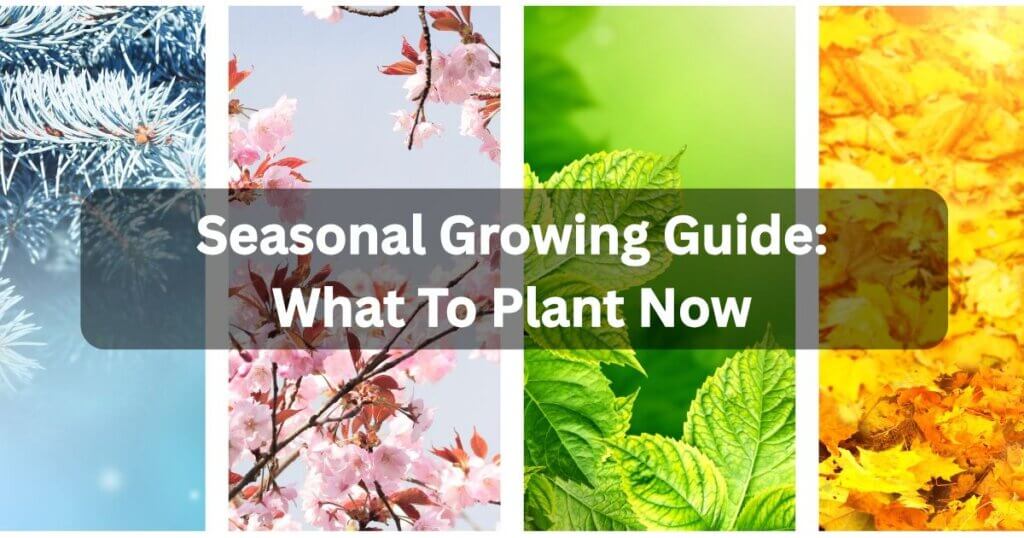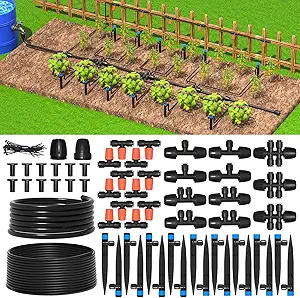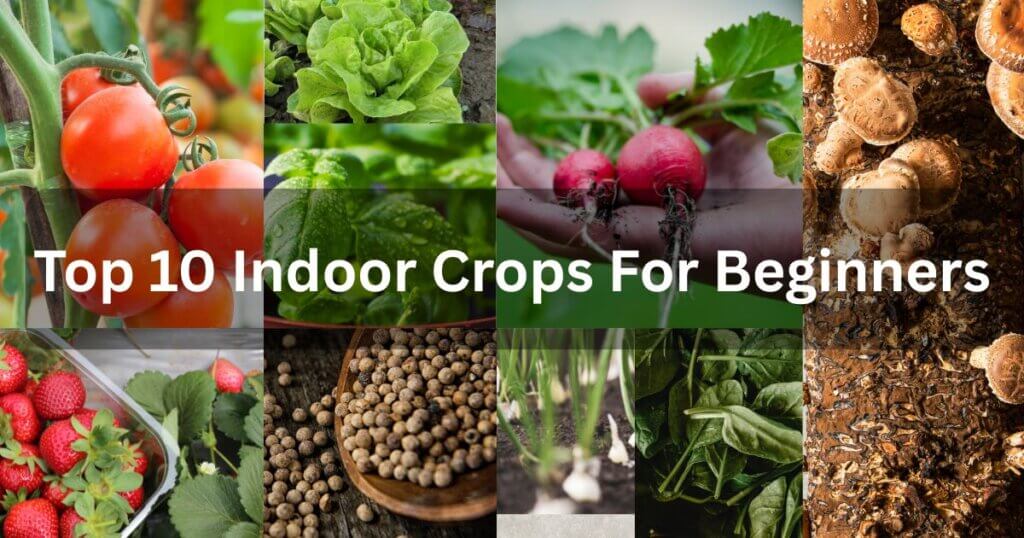Seasonal Growing Guide: What to Plant Now for a Thriving Garden All Year

Some of the links in this post are affiliate links. As an Amazon Associate, we earn a referral fee from qualifying purchases—at no extra cost to you.
Do you ever feel like you’re missing the perfect window to plant your crops? Timing is everything in gardening, and knowing what to plant right now can mean the difference between a thriving garden and a disappointing yield. This Seasonal Growing Guide: What to Plant Now is your go-to roadmap for year-round success, whether you’re planting in spring sunshine or winter’s chill.
Table of Contents
Why Seasonal Growing Matters More Than You Think
Think of your garden as a living calendar. Just like you wouldn’t wear a bikini in the snow, plants thrive best when you align your planting times with the natural rhythm of the seasons. The secret sauce to an abundant harvest? Planting the right crops at the right time. This isn’t just about yield—it’s about plant health, pest control, and even your sanity. Miss the planting window, and you may end up with stunted growth or no growth at all. So let’s get in sync with nature!
How to Use This Seasonal Growing Guide Effectively
We’ve broken this guide into the four seasons, listing what you can plant right now, based on average climate patterns. Use this as a blueprint, but always cross-check with your local USDA zone. Every region has its quirks, so adjust accordingly. Ready to get your hands dirty?
Spring Planting Guide: What to Plant Now for a Lush Start
Spring is like nature’s fresh start. The soil warms, days get longer, and plants burst to life. It’s prime time to sow seeds and plan for abundance.
Best Vegetables to Grow in Spring
Let’s talk food first. Spring is perfect for cool-weather veggies. Plant these early, and you’ll be eating fresh in no time:
- Lettuce – Quick to germinate and great for cut-and-come-again harvesting.
- Spinach – Loves the chill and bolts once it gets too hot.
- Peas – Sweet, crunchy, and best when planted early.
- Radishes – These babies mature in under a month.
The Seed Starting Greenhouse Kit is perfect for starting your spring seeds indoors. This kit provides a controlled environment that speeds up germination, ensuring your lettuce, peas, and radishes get a healthy start. It’s a favorite among gardeners who want an easy, no-mess seed-starting option.
Flowers That Thrive in Spring Sunshine
Want blooms that won’t quit?
- Pansies – Hardy and colorful, they can survive spring frosts.
- Snapdragons – Tall and elegant, they love cool temps.
- Daffodils & Tulips – Plant bulbs in fall for spring beauty.
Ideal Herbs to Start in Early Spring
Perk up your cooking and your garden with:
- Parsley – Slow to start but long-lasting.
- Cilantro – Prefers cool temps, bolts quickly in heat.
- Chives – Hardy and flavor-packed.
Summer Planting Guide: Heat-Loving Crops and Bloomers
Summer is full throttle—your garden should be, too! This is the season for warmth-loving crops and vibrant color.
Top Fruits and Vegetables to Grow in Summer
These thrive in the heat and pump out produce:
- Tomatoes – The star of summer gardens.
- Cucumbers – Fast-growing and refreshing.
- Zucchini – Produces more than you can eat!
- Peppers – Sweet or hot, they crave sunshine.
Colorful Summer Flowers to Brighten Your Garden
- Zinnias – Drought-tolerant and endlessly cheerful.
- Marigolds – Keep pests away while looking fab.
- Sunflowers – Towering and iconic.
Maintenance Tips for Summer Planting
- Water deeply, not frequently.
- Mulch to retain moisture.
- Harvest often to encourage more growth.
The Drip Irrigation Kit for Garden helps water your summer crops deeply and efficiently, exactly as your guide recommends. This kit saves water, reduces evaporation, and ensures consistent moisture for heat-loving vegetables like tomatoes and peppers.
Fall Planting Guide: Extend Your Harvest Into the Cold
Fall isn’t the end—it’s a fresh opportunity! With cooler temps and fewer pests, it’s ideal for a second wave of planting.
Cold-Hardy Vegetables to Plant Now
Fall is the encore for your greens:
- Kale – Tastes sweeter after a frost.
- Broccoli – Prefers cooler weather.
- Brussels Sprouts – Take time but worth the wait.
The Cold Frame Garden Bed allows gardeners to extend their growing season and protect cold-hardy crops such as kale and broccoli from frost. It’s simple to assemble and fits well in home gardens.
Root Crops Perfect for Autumn
- Carrots – Store well through winter.
- Beets – Vibrant and full of nutrients.
- Turnips – Underrated but versatile.
Flowers That Last Through Frost
- Chrysanthemums – A classic fall flower.
- Asters – Hardy and attract pollinators.
- Ornamental Kale – Decorative and durable.
Winter Growing Guide: Yes, You Can Grow in Winter!
It’s not just a season of rest. Winter gardening is absolutely doable with the right tools and tricks.
Crops to Grow Indoors or in a Greenhouse
- Leafy greens – Think lettuce, arugula, and mizuna.
- Microgreens – Quick, nutritious, and space-saving.
- Herbs – Basil, mint, and thyme do well indoors.
The LED Grow Light Panel for Indoor Plants provides the full spectrum your indoor winter crops and herbs need to thrive. It’s energy-efficient and designed to support healthy growth in low-light winter months.
Cold Frame Gardening for Winter Vegetables
Using a cold frame is like giving your plants a warm blanket. Grow:
- Spinach
- Kale
- Green onions
Evergreen Plants for Year-Round Beauty
Keep your garden alive with:
- Boxwood shrubs
- Winterberry
- Hellebores
Tips for Year-Round Gardening Success
Want a thriving garden all year? These are the pro tips that make it happen.
Understanding Your USDA Hardiness Zone
Your USDA Hardiness Zone determines which plants can survive in your region’s climate. It’s based on the average minimum winter temperature in your area. Knowing your zone helps you avoid planting crops that won’t make it through the season. Always double-check it before sowing any seeds.
Succession Planting for a Continuous Harvest
Succession planting means staggering your crops every 2–3 weeks instead of planting all at once. This ensures a steady harvest instead of everything maturing at the same time. It prevents waste and keeps your kitchen stocked. You’ll always have something fresh ready to pick.
Using Raised Beds and Cold Frames Effectively
Raised beds and cold frames can extend your growing season significantly. They keep soil warmer, improve drainage, and give plants a healthier start. Adding a plastic cover can turn them into mini greenhouses. This setup protects against cold snaps and boosts early growth.
Common Mistakes to Avoid When Seasonal Growing
Even the best gardeners slip up. Here’s what to dodge:
- Planting too early or late for your zone
- Ignoring frost dates
- Overcrowding crops
- Skipping soil prep between seasons
Must-Have Tools and Products for Every Season
Want to be ready no matter the weather? Keep these handy:
- Soil thermometer – Know when it’s time to plant.
- Cold frame or greenhouse kit – Extend your seasons.
- Quality compost – Year-round soil booster.
- Rain gauge – Helps monitor natural irrigation.
The Soil Thermometer is critical for knowing the perfect time to plant. This easy-to-use device gives accurate soil temperature readings quickly, helping gardeners plan their planting perfectly across all seasons.
Wrapping Up: Your Seasonal Growing Guide Cheat Sheet
Here’s a quick reference:
- Spring: Lettuce, peas, pansies
- Summer: Tomatoes, cucumbers, zinnias
- Fall: Kale, beets, mums
- Winter: Spinach (indoors), cold frames
Keep rotating, keep planting, and your garden will never be “off season.”
Conclusion: Your Garden’s Next Chapter Starts Now
Gardening isn’t just about pretty flowers or juicy tomatoes—it’s about timing, rhythm, and love. With this Seasonal Growing Guide: What to Plant Now, you’ve got the blueprint to grow smarter, not harder. So grab those gloves, get outside (or in your greenhouse), and plant what your garden—and soul—needs right now.
FAQs on Seasonal Growing Guide: What to Plant Now
1. Can I still grow anything if I missed the recommended planting window for the season?
Yes, you can! If you’ve missed the ideal planting time, consider fast-growing crops, succession planting, or starting seeds indoors with grow lights. Tools like cold frames or greenhouses can also help extend your growing window, especially for late starters.
2. How do I protect my seasonal plants from sudden weather changes like unexpected frost or heatwaves?
Unexpected weather can be tricky, but you can shield your plants with row covers, cloches, mulch, or portable shade structures. Always monitor the forecast closely and be ready with protective tools, especially during seasonal transitions.
3. What’s the best way to transition a garden from one season to the next?
Clean up dead plants, refresh soil with compost, and plan your layout based on sun changes and seasonal crop rotation. Use this downtime to prepare cold frames or raised beds, and start seeds indoors for the next season to stay ahead.
4. How do I store or preserve the produce from each seasonal harvest?
You can preserve your harvest through freezing, canning, dehydrating, or fermenting. Leafy greens freeze well, root crops store in cool dark places, and herbs can be dried or made into pestos and oils. Planning your harvest for preservation helps reduce waste.
5. Are there specific companion plants that work well in each season to improve yields or deter pests?
Absolutely! Spring: plant carrots with onions to deter root flies. Summer: marigolds deter aphids near tomatoes. Fall: garlic repels pests for kale. Winter: grow basil near indoor greens to deter mites. Companion planting enhances growth, flavor, and pest resistance.
Other Useful Resources Related To Seasonal Growing Guide: What to Plant Now
- USDA Plant Hardiness Zone Map
(Official USDA tool to determine your growing zone and planting dates) - The Old Farmer’s Almanac – Planting Calendar
(A trusted, detailed guide for what to plant each season based on your region) - National Gardening Association – Seasonal Planting Tips
(Expert advice on planting vegetables and herbs through the seasons) - Royal Horticultural Society – When to Plant What
(Comprehensive guide from the RHS on seasonal planting and crop timing) - Are Hydroponic Gardens Really Worth the Cost? (The Spruce)
Discusses the economics and year-round productivity of hydroponic systems—helpful for readers comparing shelving suited for hydroponic setups.






